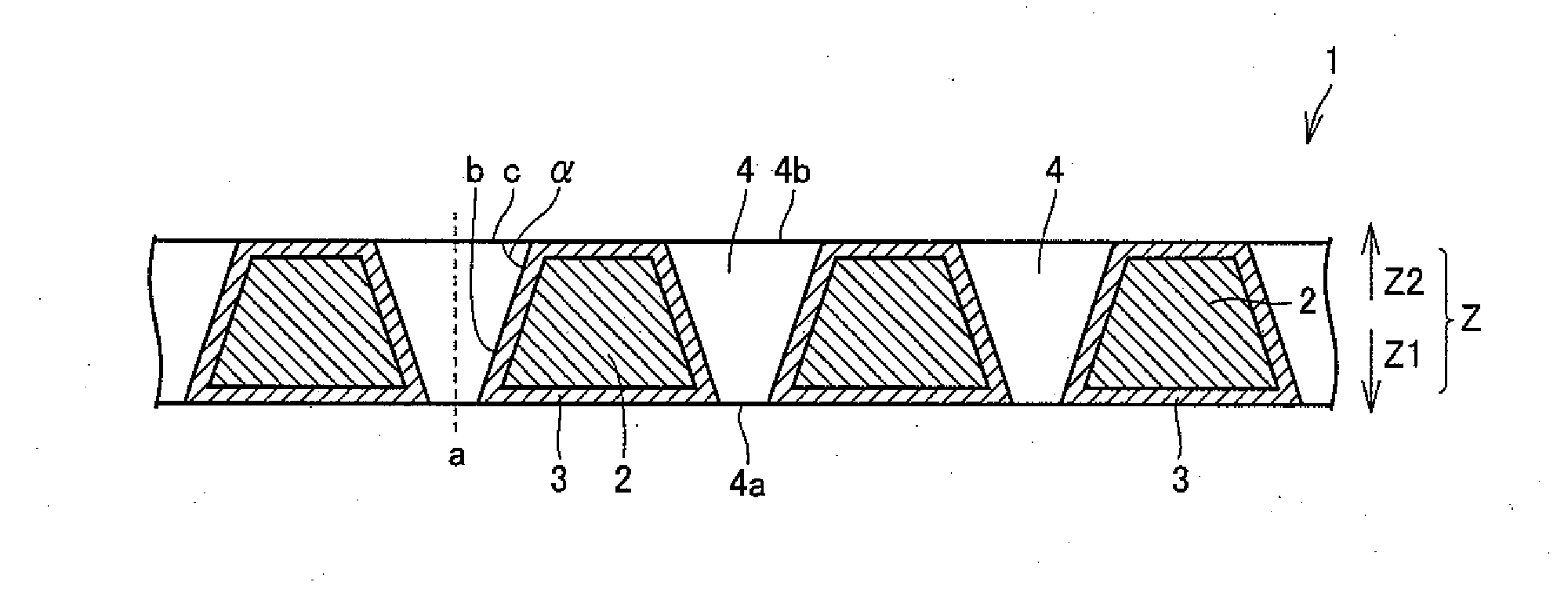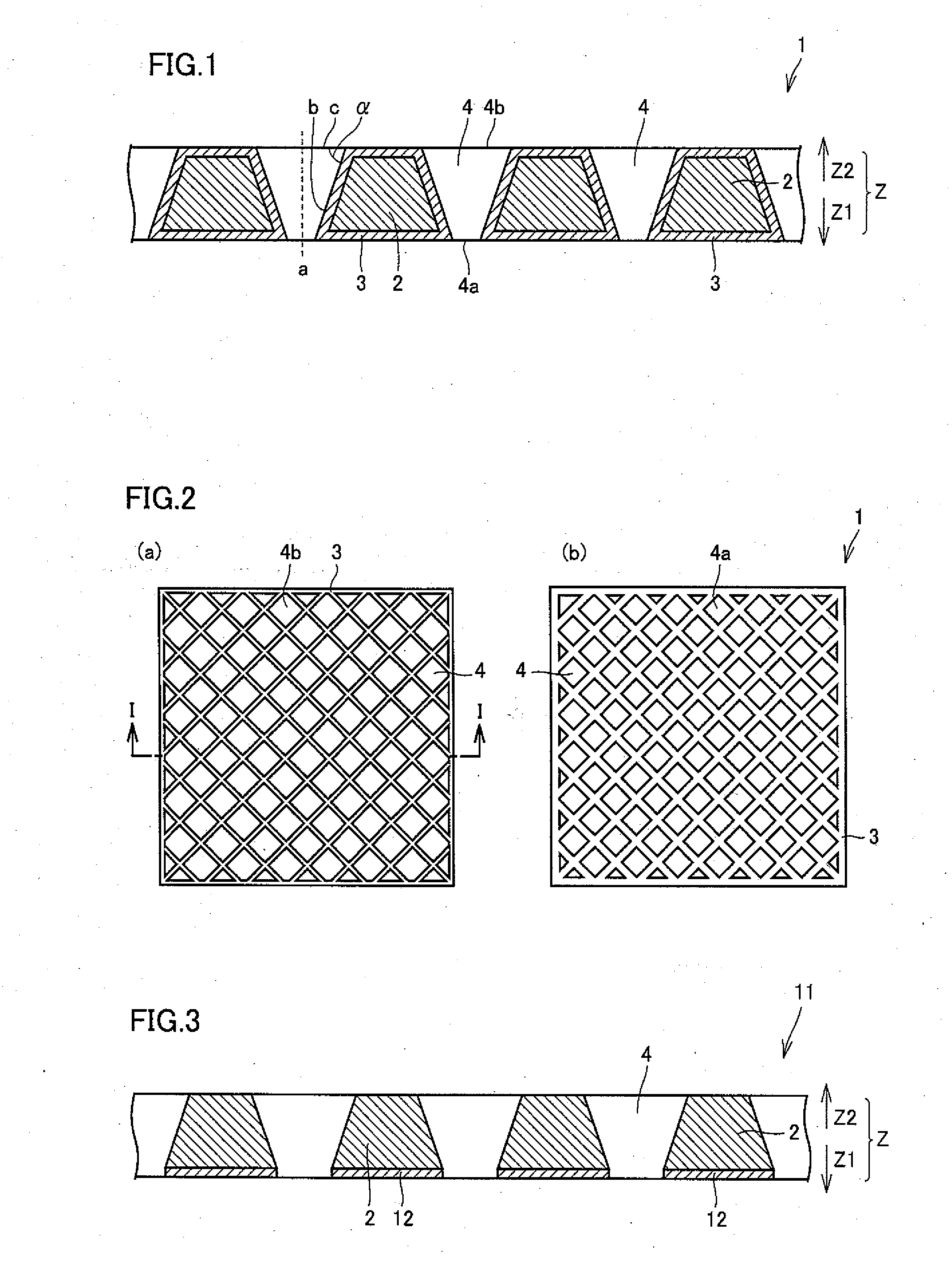Diamond electrode, method for producing same, and electrolytic bath
a technology of electrodes and electrodes, applied in silicon electrodes, electrode coatings, coatings, etc., can solve the problems of increasing the size and complexity of the apparatus, difficult to obtain high-purity ozone water, complicating the apparatus, etc., and achieves low production cost and high electrolytic efficiency. , the effect of easy production
- Summary
- Abstract
- Description
- Claims
- Application Information
AI Technical Summary
Benefits of technology
Problems solved by technology
Method used
Image
Examples
experimental example 1
[0086]A perforated substrate was prepared by working a conductive silicon substrate (P-type silicon single-crystalline substrate) 50 mm square in size and 3 mm in thickness with a fluoronitric acid solution for forming a plurality of pores from a single surface to be arranged in a staggered manner (pores having an opening diameter of 2 mm on the worked surface were formed in staggered arrangement at a pitch of 3 mm). In this working, regions other than the portions (opening portions) provided with the pores were resin-masked by resist treatment generally employed in a semiconductor fabrication process. The worked surface subjected to fluoronitric acid treatment was regarded as a surface A, and another surface so worked that the pores pass through the substrate toward the outer surface was regarded as a surface B.
[0087]Perforated substrates having various pore sizes (pore diameters), taper angles, aspect ratios and open area ratios were prepared by varying working conditions (samples...
experimental example 2
[0090]Samples of the electrolytic cell shown in FIG. 5 were prepared by employing the respective samples Nos. 1 to 10 prepared in Experimental Example 1 as anodes and cathodes. Pure water was electrolyzed through each electrolytic cell, for conducting an ozone generation experiment. A sulfonic acid-based ion-exchange membrane was used as an ion-exchange membrane, and current density was set to a condition of 1 A / cm2. Porous graphite plates were employed as collectors. Ozone generation efficiency was measured by a KI method. Table 2 shows the results.
TABLE 2SampleOpen AreaOzone GenerationNo.Ratio(%)Efficiency (%)166235317144101052716616137312084025941410506
[0091]As obvious from Table 2, generation of ozone is recognized whichever diamond electrode is employed, and it is understood that the electrolytic cell can be used for production of ozone water by electrolyzing pure water. In relation to the samples Nos. 1 to 8 having taper angles of 70 to 85°, higher ozone generation efficiency ...
experimental example 3
[0093]Diamond electrodes having various pore diameters, taper angles, aspect ratios and open area ratios were prepared similarly to Experimental Example 1, except that covering with conductive diamonds through hot filament CVD was performed not only from surfaces B of substrates but also from surfaces A for covering all of the surfaces A and the surfaces B of the substrates and inner wall surfaces of pores with the conductive diamonds (samples Ns. 11 to 22). Table 3 shows the respective pore diameters (on surfaces A), taper angles, aspect ratios and open area ratios. The average thicknesses of the conductive diamonds on the inner walls of the respective samples were measured by observing sections with an SEM. Table 3 also shows the results.
TABLE 3SamplePore Diameter ATaper AngleAspectOpen AreaThickness of ConductiveNo.(mm)(°)RatioRatio (%)Diamond on Inner Wall (μm)111.5702.025122.0701.5715132.0701.51115142.0701.51515152.0801.5288163.0701.02118173.0801.03512185.0700.63018191.5862.035...
PUM
| Property | Measurement | Unit |
|---|---|---|
| angle | aaaaa | aaaaa |
| aspect ratio | aaaaa | aaaaa |
| angle | aaaaa | aaaaa |
Abstract
Description
Claims
Application Information
 Login to View More
Login to View More - R&D
- Intellectual Property
- Life Sciences
- Materials
- Tech Scout
- Unparalleled Data Quality
- Higher Quality Content
- 60% Fewer Hallucinations
Browse by: Latest US Patents, China's latest patents, Technical Efficacy Thesaurus, Application Domain, Technology Topic, Popular Technical Reports.
© 2025 PatSnap. All rights reserved.Legal|Privacy policy|Modern Slavery Act Transparency Statement|Sitemap|About US| Contact US: help@patsnap.com



